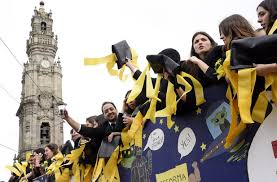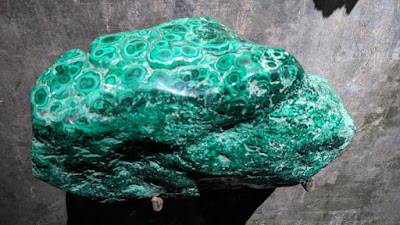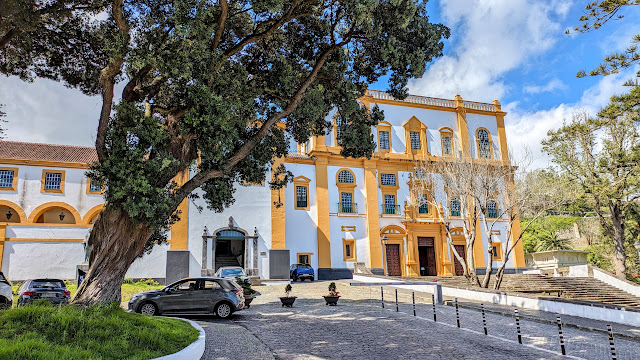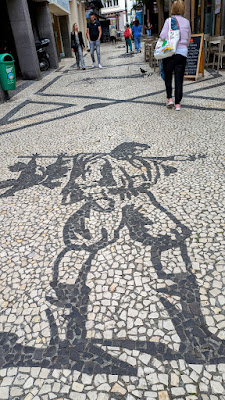Beautiful Portugal, the Azores and Madeira Islands
(May 2-18, 2024, with Overseas Adventure Travel)
Pre-trip with Jess, Braga to Aveiro to Lisbon
I flew from Salt Lake City to Paris, then to Porto, Portugal, where I was driven to Braga, the old Roman capital of Galicia, once part of Lusitania. From the eleventh century until 1910, at the end of the monarchy, Braga was ruled by archbishops. We stayed in an amazing convent, which was converted to a hospital for 500 years, and now, recently, has become the Hotel Vila Gale (pictured).
Braga is Portugal's oldest city with the youngest population, P's equivalent of "Silicon Valley"
We visited the hillside church and sanctuary of Bom Jesus do Monte (UNESCO). Next door is the hotel where Portugal's soccer team stays
April 25 marked the 50th anniversary of Portugal's Independence (end of Salazar's military dictatorship from 1937-1974, the beginning of democracy)
Our wonderful guide, Jessica Oliveira, introduced us to her shopkeeper friend.
Bishops' Palace
Porto's neoclassical Palacio da Bolsa, the city's stock market, regulated international trade, and even held the office of Gustav Eiffel when he and students built one of the many bridges crossing into the Duora Valley were the best Port wines are grown: they are processed and shipped from Gaia across the river Douro from Porto. Porto means "Invicto"=never conquered (by Napoleon).
Our fun group of 13 (after this pre-trip we would be joined by 3 more)
Portugal has a highly educated population. We loved meeting and interacting with graduating Porto University students and learned about their week-long celebrations which include friends cutting their robes and writing messages on long strips of paper which will be burned at the end in a celebration called Queimas da Fitas. Luis sang "fado" songs for us, and Ines told about messages and cape-cutting and and styling. Porto is Jessica's alma mater.
Piolho means fleas (cops) so when cops showed up students would signal each other by scratching themselves.
************
Ihavo is an old fishing village on the Costa Nova. The traditional fishermen's cottages have been repainted. Aveiro, the "Venice" of Portugal, located on the edge of an extensive lagoon system, was center of the cod-fishing industry. Fisherman caught the cod in the north Atlantic and salted it to preserve it (bacalhau). Cod, along with other fish, is still very popular
Portugal is a major producer of windmills/turbines and green energy
The Codfish Aquarium and Museum contains boats and drying racks
Cod-fishing was a tough and dangerous life.
And instead of love locks, people of Aveiro tie colorful ribbons on bridges across the canals
We visited the Vista Alegre, a prominent porcelain factory since 1824. To promote a strong relationship between the company and workers, housing facilities also included schools, church, and entertainment. A few workers still live on the premises, as do storks. We painted plates
After lunch in the workers' canteen we took a traditional molheiro to the once important salt pans (small and less important industry here today) to understand the evaporation process.
Aveiro is the Belle Epoque city of Portugal
Portugal is very big on pastries, and in northern Portugal especially those with egg yolks and sugar (ovos moles), made by the nuns after they used the whites to starch their habits.
On the way to Lisbon, we stopped at an underground museum, Alianca, to view all the valuable art and artifacts stolen by a Portuguese politician from all over the world, especially from Portugal's former colonies...pretty weird and despicable!
African (Niger) funeral pots (round for females, the others, males)
Home of Joe Berardo, the politician, whose wife died while he
was in prison. Money all tied up in a foundation.
from Lisbon to Azores to Madeira
Lisbon's beautiful Monument to the Navigators and Belem Tower (1590) at entrance to Lisbon and route to India and the spice trade. Cabral is credited with the discovery of Brazil in 1500. Vasco da Gama, the first to reach India by sea, around the Cape of Good Hope, in 1597-9. Magellan also left from this port, working for the king of Spain. Below, Jeronimos monastery/museum is in Manuellan style.
The "Golden Gate Bridge" spans the Tejo (Tagus in English) River (10 miles at some point). It was built by the (California) Oakland Bay Bridge company. Parts were brought from the U.S.
Lisbon's beautiful Monument to the Navigators and Belem Tower (1590) at entrance to Lisbon and route to India and the spice trade. Cabral is credited with the discovery of Brazil in 1500. Vasco da Gama, the first to reach India by sea, around the Cape of Good Hope, in 1597-9. Magellan also left from this port, working for the king of Spain. Below, Jeronimos monastery/museum is in Manuellan style.
The "Golden Gate Bridge" spans the Tejo (Tagus in English) River (10 miles at some point). It was built by the (California) Oakland Bay Bridge company. Parts were brought from the U.S.
Below is the Portuguese president's palace.
The Coaches Museum is supposedly the largest in the world! It is amazing, but I limited to only one photo.
Parque Eduardo VII, statue of Marques de Pompal, who renovated Lisbon in the 1700's. Pombal gradually transformed the Inquisition by bringing it under state authority, virtually abolishing it as an engine of religious thought control and using it instead against those suspected of treason against the state. In 1769 he appointed his own brother, Paulo, a layman, as Inquisitor-General. Meanwhile, Pombal had been able to end the persecution of Portuguese citizens of Jewish descent and to abolish black slavery in Portugal – in both cases primarily for economic rather than humanitarian motives. He went on to crush the Jesuits, modernise Portuguese higher education, encourage the formation of strong trading companies to exploit the wealth of Brazil for Portugal’s benefit and build up Portugal’s commercial empire. At the same time he weakened the aristocracy, established an efficient state police force and created his own apparatus of terror. He made many enemies and when King José I died in 1777, Pombal was immediately dismissed, subjected to long and brutal interrogation and banished to his country estate where he died in 1782.
The Coaches Museum is supposedly the largest in the world! It is amazing, but I limited to only one photo.
Parque Eduardo VII, statue of Marques de Pompal, who renovated Lisbon in the 1700's. Pombal gradually transformed the Inquisition by bringing it under state authority, virtually abolishing it as an engine of religious thought control and using it instead against those suspected of treason against the state. In 1769 he appointed his own brother, Paulo, a layman, as Inquisitor-General. Meanwhile, Pombal had been able to end the persecution of Portuguese citizens of Jewish descent and to abolish black slavery in Portugal – in both cases primarily for economic rather than humanitarian motives. He went on to crush the Jesuits, modernise Portuguese higher education, encourage the formation of strong trading companies to exploit the wealth of Brazil for Portugal’s benefit and build up Portugal’s commercial empire. At the same time he weakened the aristocracy, established an efficient state police force and created his own apparatus of terror. He made many enemies and when King José I died in 1777, Pombal was immediately dismissed, subjected to long and brutal interrogation and banished to his country estate where he died in 1782.
I took a taxi to the beautiful temple of the Church of Jesus Christ of Latter-day Saints in a newer section of Lisbon, but unfortunately it was just closing!
The Ferry building and gate to the city are beautiful
Portugal is known for its rich pastries, especially nata on the right.
After dinner we enjoyed listening to a fado singer accompanied (usually) by the 12-string Portuguese and regular guitar
The jacaranda trees were blooming. The wood is too heavy to float, so is not used for ship building!
From Lisbon we flew to the beautiful Azores. First to Terceira ("third") Island. Each of the 9 islands is an autonomous region of Portugal. We stayed on the beautiful Praca da Pedro (main square of the oldest city and historical capital, Angra do Heroismo, founded in 1478. Our hotel was on the right, next to the blue Imperio, one of many small shrines/chapels of the Holy Spirit, important for the start of religious processions.)
Jesuit convent and church by the main square. In 1759, the king and his minister Marquis of Pombal expelled the Jesuits from Portugal, accusing them of supporting a plot against the king's life. The Jesuits had been imprisoned and deported to Portugal since 1755, and were often the only force standing between the Indigenous and slavery. In Europe, the Jesuit expulsion from Portugal was the first in a movement that involved many other states, and the Portuguese anti-Jesuit rhetorical campaign was high
Beautiful church in the large and interesting museum of history nearby. Organ is from 15th century. Botanical Garden is also lovely.
A group of us enjoyed a home-hosted dinner by Marcia (back, right), also a restaurant owner and kindergarten teacher. Other group members went to her parents' and brother's homes.
I learned a lot at the City Hall which was also on the main square.
Great weather in the Azores! We walked from the port toward the fortresses, built in the 16-17th centuries on Monte Brasil, an extinct volcano. At the foot is Liberty Park with a statue commemorating the dispossessed, persecuted, deported of the world. One of them is....
Jesuit convent and church by the main square. In 1759, the king and his minister Marquis of Pombal expelled the Jesuits from Portugal, accusing them of supporting a plot against the king's life. The Jesuits had been imprisoned and deported to Portugal since 1755, and were often the only force standing between the Indigenous and slavery. In Europe, the Jesuit expulsion from Portugal was the first in a movement that involved many other states, and the Portuguese anti-Jesuit rhetorical campaign was high ly influential across Europe, especially in Spain. They failed to establish themselves in Japan.
ly influential across Europe, especially in Spain. They failed to establish themselves in Japan.
Beautiful church in the large and interesting museum of history nearby. Organ is from 15th century. Botanical Garden is also lovely.A group of us enjoyed a home-hosted dinner by Marcia (back, right), also a restaurant owner and kindergarten teacher. Other group members went to her parents' and brother's homes.
I learned a lot at the City Hall which was also on the main square.
Great weather in the Azores! We walked from the port toward the fortresses, built in the 16-17th centuries on Monte Brasil, an extinct volcano. At the foot is Liberty Park with a statue commemorating the dispossessed, persecuted, deported of the world. One of them is....
Gungunhana, the last tribal king of Gaza (now Mozambique) who rebelled against Portuguese domination. Brazil became independent in 1832-4.
After lunch at a local restaurant, we passed by the bull ring, then headed off to caldera.
Down, down, down into the 300 foot deep cavern associated with the caldera of the Guilherme Moniz volcano, Algar (=hole) do Carvao. We love our new group leader Mauro Sengo (the tall guy!)
Next we drove to the north of Terceira Island to the rural village of Biscoitos, known for its black volcanic rocks forming natural pools.
The rich volcanic soil in this region of the Azores is also ideal for producing Verdelho, a white wine in curraletas (small vineyards) and even in holes, checkered with higher black basalt walls which protect the vines from the salty winds.
Americans abandoned so many homes (still vacant)
Some of the social housing. Photos of children she has successfully helped connect to relatives.
*****************
Praia da Vitoria and its colorful Imperio
A former whaling boat and harbor in San Mateus
Ricardo from Angola (forme
In the evening we climbed the hill to watch the "running of the bulls" from behind a wall with all the locals. The bull, who is angry but not harmed, is on a long rope within a marked off area.
Interesting, but the earlier part of the day, was a favorite, spent at gorgeous Lagoa das Sete Cidades.
We drove in SUVs up windy hilly roads to the most gorgeous complex of fresh water lagoons nestled in the crater of a dormant volcano. The panoramas are exquisite, breath-taking!
Ponta Delgada is the Azores' largest city and San Miguel the most populous island with 140,000 inhabitants
Our assignment in the market was to buy items for our picnic, but jokesters Terry and Kevin bought a pumpkin in lieu of their assigned item. Mauro made them return it!
We stopped to see the waterfalls ......
before visiting the dairy farm Quinta do Amago, family farm owned by Joao and Jena, a wonderful couple. Both are of Portuguese descent, but she grew up mostly in California and attended UC Berkeley
Three of us milked a cow (it was easy!) and then we had a yummy meal of empanadas, cheeses, bread, fruit, tarts, etc.
We traveled through the green hills on our way back to Aveiro
May 14 we drove to Lagoa das Furnas, an area containing a crater lake with a series of volcanic hot springs. We swam in the mineral pool (95-105 degrees) at Terra Nostra Park (nice gardens of past-blooming camelias)
Using the steam of the earth, our lunch (meats, cabbage, potatoes) was cooked for 5 hours in a large pot in the hot ground.
In the afternoon we visited the lush Gorreana Tea Plantation, the only green/black tea operation in Europe, and had a lovely tea party with pineapple cake in the Gorreana family dining room
We loved the coastal views on the way back to Ponta Delgada
May 15 we flew from the Azores to Madeira, 600 miles southeast of the Azores, off the coast of Morocco.
Above, the Jesuit church, below, the city hall, and outside, thousands of shops and tourists, motorcycles, flowers, food, and wonderful mosaic streets and walks. The basalt stones were often ballast in the ships; the white, limestone.
Always lots of wine tasting
I've never seen such a variety of dried fruits. This bread bola is slightly sweet and delicious
Waiting for our zodiac to take us dolphin (we saw many, but too fast to capture on film and my camera not working well!) and whale watching (none). The water was calm and it was very pleasant! Brazilian soccer player had a home overlooking the harbor.
We rode the teleferico up the hill, then John, Nancy and I took a wild cesta (wicker basket on runners used formerly to transport pigs, chefs and ??) ride twisting and turning at high speed down the narrow walled, car-lined street to a half-way point, and walked the rest of the way down the steep hill.
The last day's optional afternoon trip was to spectacular western Madeira. The views were amazing!!
We visited a glass floor lookout at 580 feet above the coastline.
and a small fishing village, where Winston Churchill regularly came to paint from his hotel balcony
Mauro brought seed to feed the chaffinches
Old farmers' homes with cane roofs in the Santana region are charming. We visited a 240 year old house, the owner a descendant. Kitchen and bathroom were added later.
Quinta do Fural restaurant had an amazing view of the north coast
A rum factory requires only sugar cane, machines and hard work!
We drove in SUVs up windy hilly roads to the most gorgeous complex of fresh water lagoons nestled in the crater of a dormant volcano. The panoramas are exquisite, breath-taking!
Ponta Delgada is the Azores' largest city and San Miguel the most populous island with 140,000 inhabitants
Our assignment in the market was to buy items for our picnic, but jokesters Terry and Kevin bought a pumpkin in lieu of their assigned item. Mauro made them return it!
We stopped to see the waterfalls ......
before visiting the dairy farm Quinta do Amago, family farm owned by Joao and Jena, a wonderful couple. Both are of Portuguese descent, but she grew up mostly in California and attended UC Berkeley
Three of us milked a cow (it was easy!) and then we had a yummy meal of empanadas, cheeses, bread, fruit, tarts, etc.
We traveled through the green hills on our way back to Aveiro
May 14 we drove to Lagoa das Furnas, an area containing a crater lake with a series of volcanic hot springs. We swam in the mineral pool (95-105 degrees) at Terra Nostra Park (nice gardens of past-blooming camelias)
Using the steam of the earth, our lunch (meats, cabbage, potatoes) was cooked for 5 hours in a large pot in the hot ground.
In the afternoon we visited the lush Gorreana Tea Plantation, the only green/black tea operation in Europe, and had a lovely tea party with pineapple cake in the Gorreana family dining room
We loved the coastal views on the way back to Ponta Delgada
May 15 we flew from the Azores to Madeira, 600 miles southeast of the Azores, off the coast of Morocco.
In Funchal (=fennel) our Cast anheiro boutique hotel was blessed with a rooftop swimming pool and very delicious breakfast.
anheiro boutique hotel was blessed with a rooftop swimming pool and very delicious breakfast.
Above, the Jesuit church, below, the city hall, and outside, thousands of shops and tourists, motorcycles, flowers, food, and wonderful mosaic streets and walks. The basalt stones were often ballast in the ships; the white, limestone.
Always lots of wine tasting
I've never seen such a variety of dried fruits. This bread bola is slightly sweet and delicious
Waiting for our zodiac to take us dolphin (we saw many, but too fast to capture on film and my camera not working well!) and whale watching (none). The water was calm and it was very pleasant! Brazilian soccer player had a home overlooking the harbor.
We rode the teleferico up the hill, then John, Nancy and I took a wild cesta (wicker basket on runners used formerly to transport pigs, chefs and ??) ride twisting and turning at high speed down the narrow walled, car-lined street to a half-way point, and walked the rest of the way down the steep hill.
The last day's optional afternoon trip was to spectacular western Madeira. The views were amazing!!
We visited a glass floor lookout at 580 feet above the coastline.
and a small fishing village, where Winston Churchill regularly came to paint from his hotel balcony
That morning we had taken a lovely walk along a levada, a system of irrigation channels (requiring 15 miles of tunnels) designed in the 16th century that transport water through the mountains from northwest and west to the drier south. Ribeiro frio lies in the center of Madeira Island
Mauro brought seed to feed the chaffinches
Old farmers' homes with cane roofs in the Santana region are charming. We visited a 240 year old house, the owner a descendant. Kitchen and bathroom were added later.
Quinta do Fural restaurant had an amazing view of the north coast
A rum factory requires only sugar cane, machines and hard work!
Below, a water park.
Back in Funchal, the bustling capital of Madeira, I had to take photos of the historical cultural motifs in black basalt stones
The mainland Portuguese founded the islands in 1419. Wine, fish, sweet fruits, including bananas (the islands only produce small sweet ones, the EU won't accept), and tourism are main sources of income
Baden Powell, the founder of Scouting, must have loved Madeira, too!
The long skinny scabbard (sword) fish was delicious
Our farewell dinner was in a restaurant near the port, once a mansion. We toast our great guide Mauro, a Lisbon native, and wish Happy birthday to John, on left) who turns 80 May19. And goodbye to a great group of new friends and a beautiful land and culture.
Saturday, May 18, I got picked up at 4 am for the long long flight to Lisbon, then JFK to Salt Lake City. From Lisbon to SLC I sat amongst the very tall BYU men's volleyball team. The handle of my trusty green suitcase wouldn't go down, so ever vigilant and helpful Terry retrieved me another one from the sidewalk! I left the old one for ???
I came home with happy memories and new friends, to a yard with trees that finally had leaves and flowers, and weeds to pull! And snow still on the mountains.
Back in Funchal, the bustling capital of Madeira, I had to take photos of the historical cultural motifs in black basalt stones
The mainland Portuguese founded the islands in 1419. Wine, fish, sweet fruits, including bananas (the islands only produce small sweet ones, the EU won't accept), and tourism are main sources of income
Baden Powell, the founder of Scouting, must have loved Madeira, too!
The long skinny scabbard (sword) fish was delicious
Our farewell dinner was in a restaurant near the port, once a mansion. We toast our great guide Mauro, a Lisbon native, and wish Happy birthday to John, on left) who turns 80 May19. And goodbye to a great group of new friends and a beautiful land and culture.
I came home with happy memories and new friends, to a yard with trees that finally had leaves and flowers, and weeds to pull! And snow still on the mountains.

























































































































































































































No comments:
Post a Comment